Desmos Graphing Calculator - Math graphing tool
Unleash your inner mathematician with graphing and scientific calculations.

- 7.37.0.0 Version
- 4.3 Score
- 4M+ Downloads
- Free License
- 3+ Content Rating
At Desmos, we have a vision of a world where math literacy is universal and believe in making math accessible and enjoyable for all students. Our approach emphasizes learning through practice.
To realize this vision, we have developed the next generation of graphing calculator. With our powerful math engine, the calculator can instantly plot various equations, ranging from simple lines and parabolas to more complex derivatives and Fourier series. Sliders allow for easy demonstration of function transformations. It presents math in an intuitive and visually appealing manner, and the best part is that it's completely free.
Keyboard shortcuts
Windows / ChromeOS Shortcuts
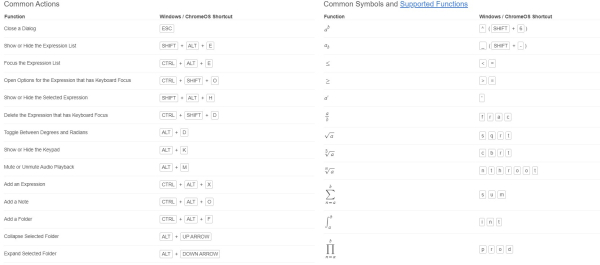
Getting Started: Desmos Graphing Calculator
1. Get Started Graphing
When you visit the graphing calculator, you'll see a place to write expressions on the left and a grid on the right. You can use the expression list to plot points, graph equations, evaluate expressions, and more.

ADD NEW ITEMS
Click just below an existing expression or press "enter" from an existing expression to add a new blank expression. Click the plus button  in the top left to add a note, table, folder, or image. If you’d prefer not to reach for the mouse, press Ctrl and Alt along with O, T, F, I. You can also type expressions and equations directly in the line. Try typing y=2x-1.
in the top left to add a note, table, folder, or image. If you’d prefer not to reach for the mouse, press Ctrl and Alt along with O, T, F, I. You can also type expressions and equations directly in the line. Try typing y=2x-1.
USE THE KEYPAD
In the bottom left corner of the screen, you'll find a keypad button  . Click the
. Click the
keypad button to add anything you might need to your expression (including letters, numbers, symbols, and functions). Everything on the keypad can also be typed on your keyboard. Open the keyboard shortcuts list by pressing Ctrl + /, or from within the resources section by clicking on the help button  in the top right corner.
in the top right corner.
HIDE OR STYLE AN ITEM
Long-hold on the color icon  in the expression line to open a style menu for a graphed item or press Ctrl + Shift + O. Click once on the color icon to show/hide the graph of the expression item. Depending on the item, you can change the opacity, color, location of the label, and other style options.
in the expression line to open a style menu for a graphed item or press Ctrl + Shift + O. Click once on the color icon to show/hide the graph of the expression item. Depending on the item, you can change the opacity, color, location of the label, and other style options.
ORGANIZE YOUR ITEMS IN FOLDERS
After using the plus button  in the top left to add a folder, drag expression lines into the folder to group them together (a gray line will show up to the left of the
in the top left to add a folder, drag expression lines into the folder to group them together (a gray line will show up to the left of the
expression to let you know it’s in the folder). Once grouped, items in folders can be collapsed or hidden all at once.
EXPLORE A GRAPH
You can explore points of interest on a graph by using your mouse to click on them or trace along a curve. On a keyboard, press Alt + T and then H to hear the graph with audiotrace. Audiotrace is an accessibility feature in Desmos that you can use to hear the shape of a curve.
ADJUST GRAPH SETTINGS
Click on the wrench icon in the top right corner of the graph to open the graph settings menu or type Ctrl + Alt + G. Open the graph settings to adjust the domain and range of the viewport, change or hide the grid, switch between using radians and degrees for angles, and much more.
in the top right corner of the graph to open the graph settings menu or type Ctrl + Alt + G. Open the graph settings to adjust the domain and range of the viewport, change or hide the grid, switch between using radians and degrees for angles, and much more.
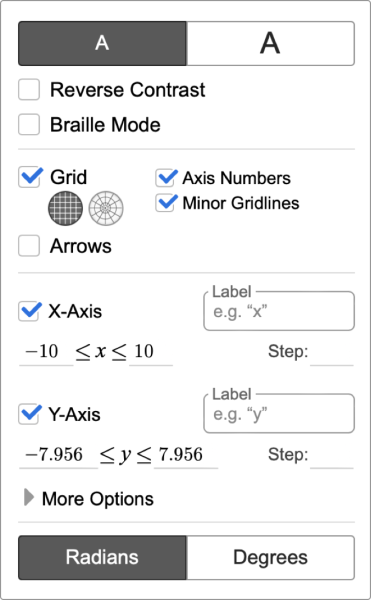
2. Log in, Save, and Share Your Graph
CREATE AN ACCOUNT
Although you can use the Desmos Graphing Calculator without signing in, in order to save your graphs, you’ll need to have an account. If you press the save button while signed out, it will prompt you to sign in or create an account. To create an account, choose the blue sign up button  in the top right corner to make an account with an email address or by signing up with Google or Apple. You will use this same account to log in to the Desmos Geometry Tool.
in the top right corner to make an account with an email address or by signing up with Google or Apple. You will use this same account to log in to the Desmos Geometry Tool.
SAVE YOUR GRAPH
When you make changes to your graph, a save button will appear in the top left of your graph when changes have been made. As you make additional changes to the graph, the save button will reappear. To save any updates or changes, you will need to click the save button  or type CTRL + S.
or type CTRL + S.
ACCESS YOUR SAVED GRAPHS
To access all of your saved graphs, click on the hamburger menu  in the upper left corner or type CTRL + O. To open any of your saved graphs, click or Tab to the graph’s name in this menu and select ‘Open Graph.’
in the upper left corner or type CTRL + O. To open any of your saved graphs, click or Tab to the graph’s name in this menu and select ‘Open Graph.’
SHARE A GRAPH
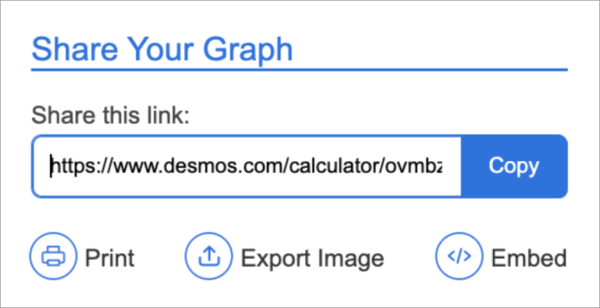
From the share menu, you can print or export an image of your graph. You can also copy a link to your graph or an embed code. To open the share menu, click on the share button  in the top toolbar of the calculator or type CTRL + ALT + S.
in the top toolbar of the calculator or type CTRL + ALT + S.
SHARE A GRAPH

From the share menu, you can print or export an image of your graph. You can also copy a link to your graph or an embed code. To open the share menu, click on the share button  in the top toolbar of the calculator or type CTRL + ALT + S.
in the top toolbar of the calculator or type CTRL + ALT + S.
Tutorial for users
Plotting Points and Graphing Curves
When you visit the graphing calculator, you will find the expression list on the left and a grid on the right. In the expression list, you can enter coordinates, expressions, equations, and more. Try entering a point like (1,3)(1,3), graphing a line like y=−2x+4y=−2x+4, or graphing a parabola like y=x2+1y=x2+1. You can turn on and off any expression by toggling on and off the colored icon to the left of your expression.
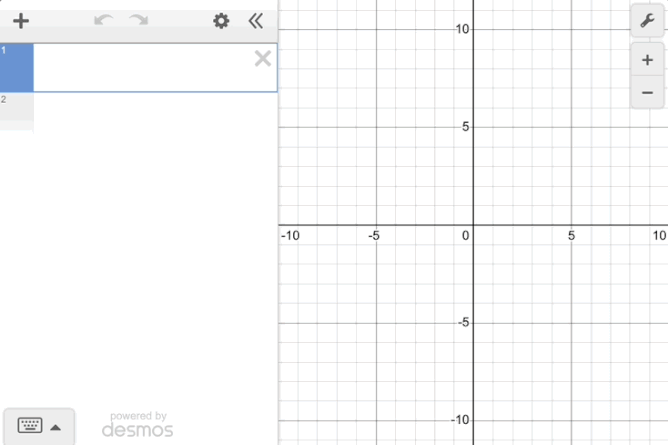
Points of Interest
When you graph an expression or equation, you will notice points of interest in gray on your graph. For example, when you graph f(x)=−2x+4f(x)=−2x+4 you will see two points of interest for the x and y intercepts. Graphing another function, like g(x)=x2+1g(x)=x2+1, will show the points of intersection of the two curves. To see the points of interest, select the curve you’re interested in (you can click on it on the graph or on its expression line). Hover over the points of interest to reveal the labeled coordinates of the point. Select a point to display the label (the label will remain on the screen until you deselect the point).
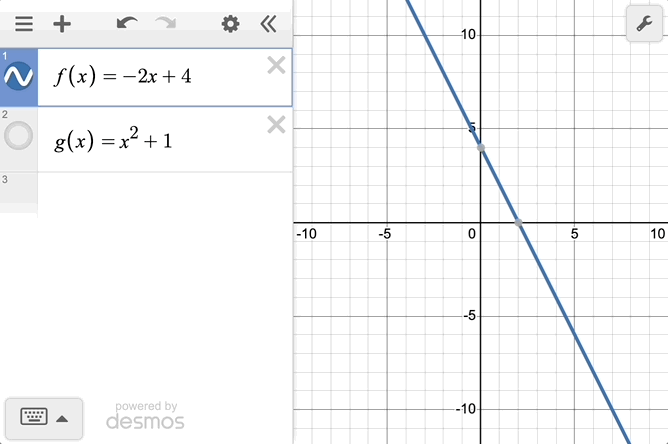
Evaluating a Function
One way to evaluate a function is to use function notation. Continuing with the example above, we can evaluate the function f(x)=−2x+4f(x)=−2x+4 by substituting in different values such as f(0)f(0) or f(5)f(5) in another line. To see multiple values at once, you can create a function table. If you press the ‘edit list’ button on the top right of the expression list, you will see a ‘create table’ button that can be used to plot a table of input and output values that match your function. By default, a function table plots points for the input (x)(x) values from -2 to 2. You can press return to add a row and enter more values in the xx column to evaluate in your function. You can also delete any of the input values and choose others.
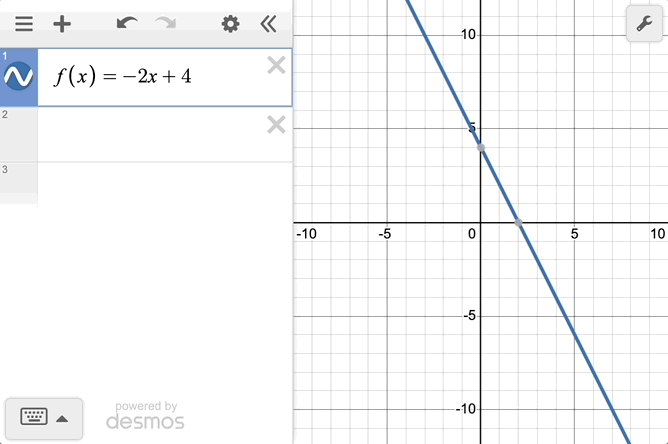
Navigating a Graph
To move around the graph, you can click on the graph paper and drag to pan. Zoom in and out using the plus and minus buttons on the graph. To set the viewing window to a specific domain and range, open the settings menu using the wrench icon and enter a lower and upper bound for the x and y axes. If you want to return to the original view, press the home button.
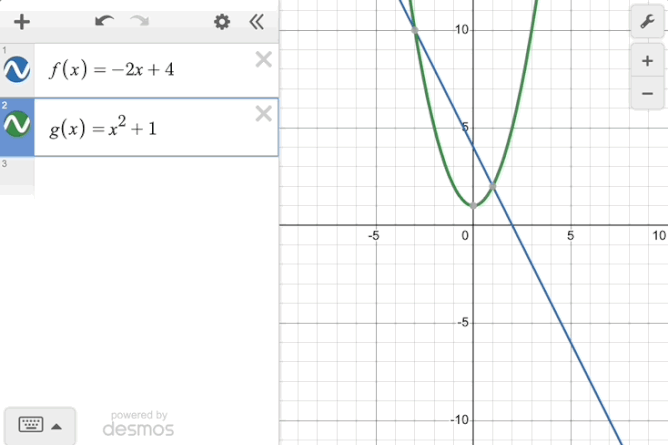
Save and Share your Graph
To save your graph, press the save button in the upper left corner. If you’re not logged in, the calculator will prompt you to log in or create an account before saving. To access your saved graphs, click on the ‘open graph’ icon in the upper left hand corner. You can also share a link or export an image of your graph by using the ‘share graph’ button next to your account name.
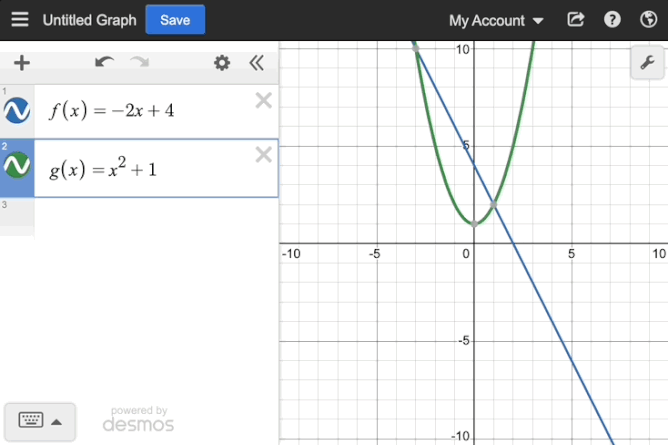
What's New
New Look, Same Dynamic Geometry Tool
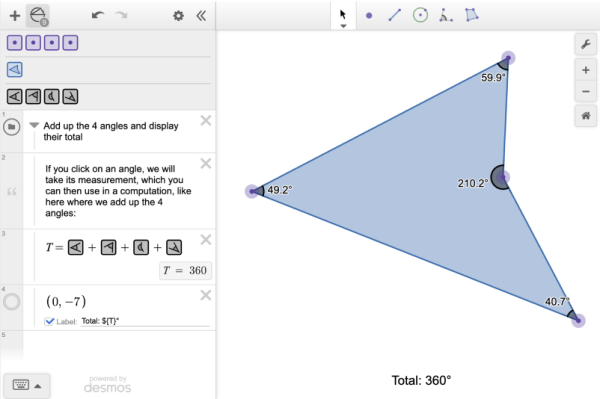
What's New with Constructions
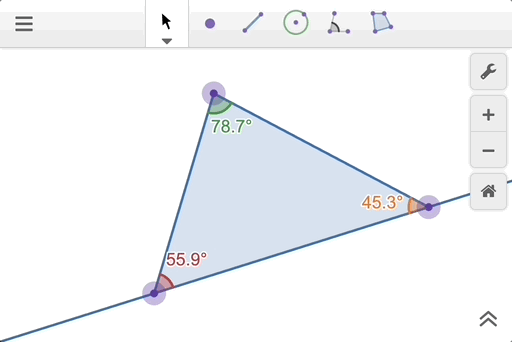
You can now construct off of an object after you select it.
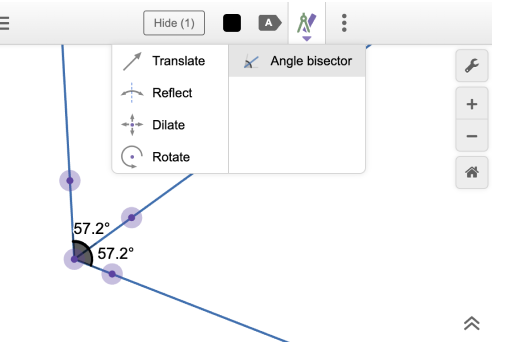
We’ve added an angle bisector tool!

From the more options menu (vertical 3 dot icon), you can delete selected objects, change points to be draggable, or move object definitions from the token navigator to the expression list.
It’s now easier to label objects and change their color.
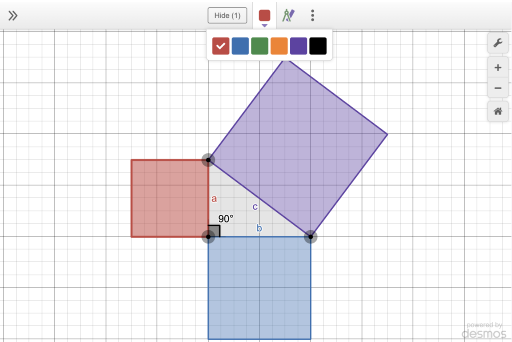
After selecting a point, angle, or segment, label it or change its color directly from the menu that pops up.
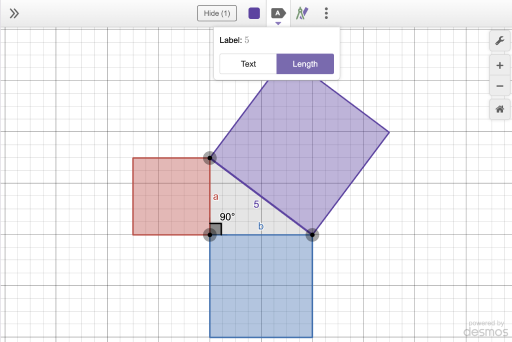
With a segment or angle selected, choose to label with text or the measurement.

You can also label points with their coordinates! To do so, turn on the axes in the graph settings menu and select the point to label it.
Key Features:
- Graphing: Plot polar, Cartesian, or parametric graphs without any expression limit, and no need to input expressions in y= form.
- Sliders: Interactively adjust values to develop intuition or animate parameters for visualizing their impact on the graph.
- Tables: Input and plot data or create input-output tables for functions.
- Statistics: Identify best-fit lines, parabolas, and more.
- Zooming: Scale axes independently or simultaneously with finger pinching, or customize the window size manually for precise adjustments.
- Points of Interest: Touch a curve to reveal maximums, minimums, and points of intersection; tap gray points to view coordinates; drag along a curve to observe coordinate changes under your finger.
- Scientific Calculator: Enter any equation for solving and Desmos will display the solution, handling square roots, logarithms, absolute values, and more.
- Inequalities: Plot Cartesian and polar inequalities.
- Offline Use: No internet connection required.
For more information and access to the free online version of our calculator, please visit www.desmos.com.
- Version7.37.0.0
- UpdateJul 31, 2025
- DeveloperDesmos Inc
- CategoryEducation
- Requires AndroidAndroid 8.0+
- Downloads4M+
- Package Namecom.desmos.calculator
- Signatureb8facc786ae89a96d09dd997e7964802
- Available on
- ReportFlag as inappropriate
-
NameSizeDownload
-
6.25 MB
-
6.43 MB
-
6.35 MB


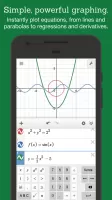
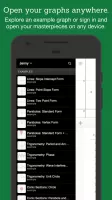
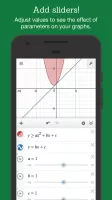


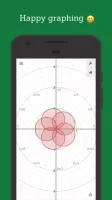
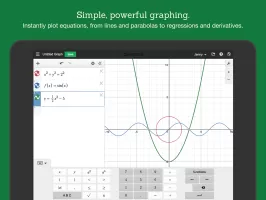
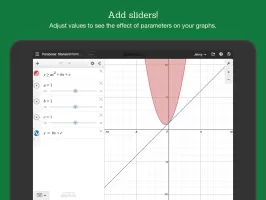
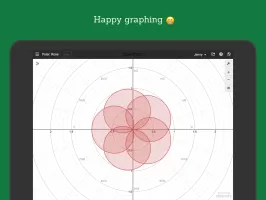





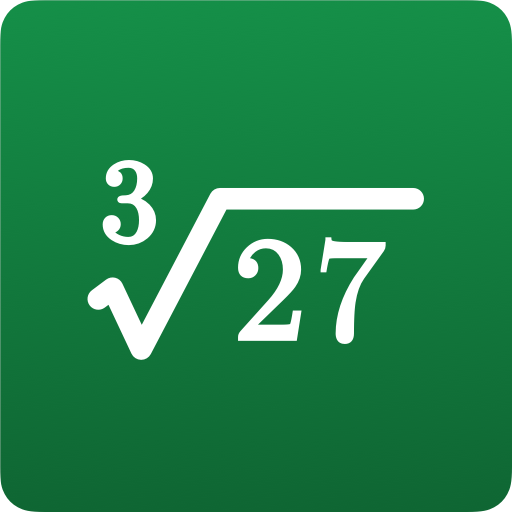











Supports drawing various types of graphs such as polar coordinates, rectangular coordinates, and parametric equations
Allows the use of sliders to dynamically adjust parameters, helping users intuitively understand the changes in functions and graphs
Provides statistical analysis tools such as best fit lines and parabolas
Completely free to use
The interface lacks visual appeal
For users who are not familiar with mathematical concepts, it still takes some time to adapt and learn how to use the tool effectively